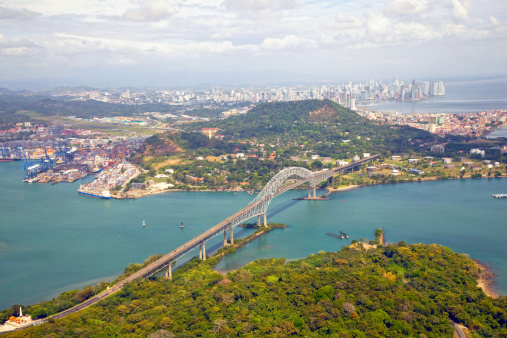My wife and I spent the last nine days of 2014 exploring the Panama isthmus. We ventured to the Pacific beaches; to the jungle; to Panama City, a surprisingly expansive and towering metropolis; and, of course, to the Panama Canal.
 Most people conflate Panama with its canal. It’s easy to understand why. To see massive Panamax container ships pass through narrow locks with a foot or two to spare on either side is inspiring. It instills faith in humankind’s ability to adapt and innovate.
Most people conflate Panama with its canal. It’s easy to understand why. To see massive Panamax container ships pass through narrow locks with a foot or two to spare on either side is inspiring. It instills faith in humankind’s ability to adapt and innovate.
As I marveled at the process of ships moving from one ocean to another, I couldn’t help but think the canal was close to being the perfect business: Ships must either pass through the canal or trudge down along the shores of South America and navigate the treacherous waters off Cape Horn.
[ad#Google Adsense 336×280-IA]The latter course requires three weeks to put you on the other side of Panama.
A trip through the canal requires 10 hours.
Of course, you could unload one ship on one side of Central America, ship by rail to the other side, and reload on another ship.
But the Panama Canal has that covered too; it offers rail service to both oceans.
It appears, then, the canal has one of the best economic moats in the world.
You could say that the canal’s moat is impenetrable.
Except that it isn’t. The canal isn’t perfect, and many Panamanians fail to appreciate this fact.
To be sure, the canal, run by the private Panama Canal Authority, is a cash-generating machine. The average price for a one-way ticket is $54,000. Many ships pay much more than the average. The cruise ship Norwegian Pearl paid a record $375,600 toll in 2010. A couple of locals told me that the Pearl has since paid more than $400,000.
Collecting tolls is also a high-margin business. In 2013, the Panama Canal Authority collected over $1.8 billion in tolls. Toss in ancillary services and total revenue bumps up to $2.4 billion. Once all the bills were paid, the Panama Canal Authority earned $1.3 billion. That’s a remarkable 54% net income margin.
But there’s a catch. The Panama Canal Authority transfers half its net income to the Panamanian treasury. In 2013, it transferred $649 million. For all of 2013, the treasury received nearly $1 billion in contributions from the Panama Canal Authority, or roughly 15% of the government’s revenue.
The canal’s largesse enables government to bestow a wealth of benefits to Panama’s inhabitants: senior citizen discounts, low-income housing, and subsidized mortgage lending are to scratch the surface. Low income tax rates benefit everyone. The canal is viewed by locals and ex-pats alike as the proverbial golden-egg-laying goose. What’s more, they expect the goose to deposit golden eggs in perpetuity.
My take is different. I found many Panamanians and ex-pats naively cavalier to the canal’s business vulnerability.
When I raised the specter of a possible Nicaragua canal and what that would mean to the golden-egg-laying goose, I was met with a dismissive hand wave and a rote reply: “The Nicaragua Canal has been talked about for years. It will never happen.”
I’m included to believe something is happening in Nicaragua. The Chinese company HKND Group (with likely backing by China’s government) and the Nicaraguan government broke ground in December on a $50 billion 172-mile transoceanic canal across Nicaragua. The Nicaragua Canal is expected to take five years to complete and accommodate larger ships than the Panama Canal, even after that canal completes its $7-billion expansion.
And if something isn’t happening in Nicaragua, why did the Panama Canal Authority approve a new container terminal and a reduced toll structure for liner operators? And why is the Panama Canal Authority set to introduce a loyalty program, for the first time ever, for container shippers?
The Chinese/Nicaraguan venture in canal building could come to naught. A Nicaraguan canal has been discussed for decades. That said, many Panamanians are in denial to the potential threat to their beloved franchise. No challenger can possibly traverse such a deep and wide economic moat, they reason . . . until one does.
Investors are also frequently blinded to impending threats by similar conscience-soothing denial. But if history serves as a guide, all moats around stocks will be eventually be traversed. General Electric (NYSE: GE), IBM (NYSE: IBM), General Motors (NYSE: GM), Microsoft (NASDAQ: MSFT) were at one time extraordinarily profitable companies and believed to be impervious to competition. Google (NASDAQ: GOOG), Apple (NASDAQ: AAPL), and Facebook (NADSAQ: FB) are perceived similarly today.
When extraordinary profits are made, you can be sure extraordinary competition will eventually arise. Many Panamanians don’t get it. Then again, neither do many investors. That is, until they are forced to get it, which inevitably happens.
— Steve Mauzy
[ad#wyatt-income]
Source: Wyatt Investment Research
